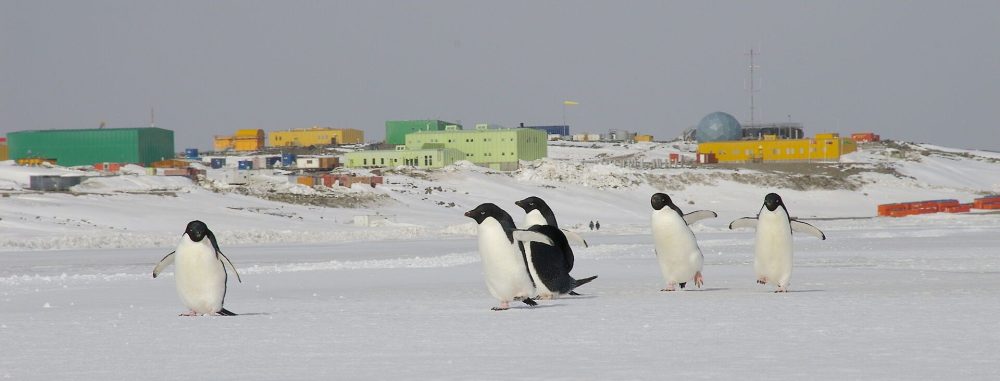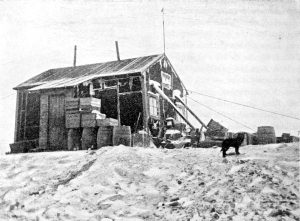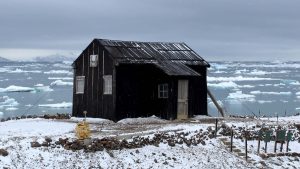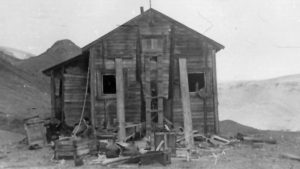 |
 Nordenskjöld’s Hut aka Nordenskjöld House (64°21’49” South, 56°59’ 30” West) is a log hut built in February 1902 by the main body of the Swedish South Pole Expedition led by Otto Nordenskjold, who used the Snow Hill island (aka Cerro Nevado island) on the east coast of the Antarctic Peninsula as a base to explore the surrounding areas between 1901 and 1903. Currently, the Argentine Republic administers it as the Sweden refuge.
Nordenskjöld’s Hut aka Nordenskjöld House (64°21’49” South, 56°59’ 30” West) is a log hut built in February 1902 by the main body of the Swedish South Pole Expedition led by Otto Nordenskjold, who used the Snow Hill island (aka Cerro Nevado island) on the east coast of the Antarctic Peninsula as a base to explore the surrounding areas between 1901 and 1903. Currently, the Argentine Republic administers it as the Sweden refuge.
Since July 26, 1965 Refugio Suecia is a National Historic Monument of Argentina, by decree No. 6058/1965 and as part of the Province of Tierra del Fuego , Antarctica and South Atlantic Islands. It is also protected by the Antarctic Treaty, which designated it a 38th Historic Site and Monument, through ATCM VII-9 designation of 1972 and following a joint proposal between Argentina and the UK to the Antarctic Treaty Consultative Meeting
 The Argentine Navy took possession of the Refuge on January 8, 1954, renaming it Refugio Suecia and proceeded to its restoration. On that day the frigate Captain Luis T. De Villalobos, commander of the transport ARA Bahia Aguirre, took possession of the Refuge facilities on behalf of the Government of the Argentine Republic and recorded the new name. On the same day in its vicinity the Betbeder Naval Shelter was built. The Hut was used as a base for reconnaissance research in the summers of 1953-1954 and 1954-1955. In the early 1960s it had a warehouse with provisions for three people for three months.
The Argentine Navy took possession of the Refuge on January 8, 1954, renaming it Refugio Suecia and proceeded to its restoration. On that day the frigate Captain Luis T. De Villalobos, commander of the transport ARA Bahia Aguirre, took possession of the Refuge facilities on behalf of the Government of the Argentine Republic and recorded the new name. On the same day in its vicinity the Betbeder Naval Shelter was built. The Hut was used as a base for reconnaissance research in the summers of 1953-1954 and 1954-1955. In the early 1960s it had a warehouse with provisions for three people for three months.
The Refuge has been restored by the Argentine Antarctic Institute. It is enabled as a Museum and contains original objects of the expedition. Its conservation is carried out by Argentina and Sweden.
History
On February 12, 1902, the Swedish Antarctic Expedition led by Otto Nordenskjöld arrived on Cerro Nevado Island aboard the sailboat Antarctic provided with an auxiliary steam engine. The Captain of the ship was Carl Anton Larsen.
 The leader of the expedition had to spend the winter on the island along with meteorologist Gösta Bodman, sailor Gustav Akerlund, all of them of Swedish nationality, and Argentine Josè Maria Sobral, ensign. They would carry out meteorological, magnetic, astronomical and hydrographic work, as well as expeditions on the sea ice to the neighboring islands and to the nearby area of the Antarctic Peninsula, a region later known as the Nordenskjold Coast, and which extends to the southwest of the island.
The leader of the expedition had to spend the winter on the island along with meteorologist Gösta Bodman, sailor Gustav Akerlund, all of them of Swedish nationality, and Argentine Josè Maria Sobral, ensign. They would carry out meteorological, magnetic, astronomical and hydrographic work, as well as expeditions on the sea ice to the neighboring islands and to the nearby area of the Antarctic Peninsula, a region later known as the Nordenskjold Coast, and which extends to the southwest of the island.
On the northeast coast of the island a prefabricated wooden hut was mounted, covered externally with cardboard sheets ember bounded.
and

Cabane de Nordenskjöld alias Maison Nordenskjöld (64°21’49’ Sud, 56°59′ 30′ Ouest) est une cabane en rondins construite en février 1902 par le corps principal de l’expédition suédoise au pôle Sud dirigée par Otto Nordenskjold, qui a utilisé l’île de Snow Hill (alias Cerro Nevado) sur la côte est de la péninsule antarctique comme une base pour explorer les zones environnantes entre 1901 et 1903. Actuellement, la République argentine l’administre comme refuge suédois.
Depuis le 26 juillet 1965, le Refugio Sueciaest unmonument historique national d’Argentine, par décret n° 1. 6058/1965 et faisant partie de la province de la Terre de Feu, de l’Antarctique et des îles de l’Atlantique Sud. Il est également protégé par le Traité sur l’Antarctique, qui l’a désigné 38ème Site et Monument Historiques, par désignation ATCM VII-9 de 1972 et suivantes une proposition conjointe entre l’Argentine et le Royaume-Uni à la réunion consultative du Traité sur l’Antarctique

La marine argentine a pris possession du Refuge le 8 janvier 1954, l’a renommé Refugio Suecia et a procédé à sa restauration. Ce jour-là, la frégate Capitaine Luis T. De Villalobos, commandant du transport ARA Bahia Aguirre, a pris possession des installations du Refuge au nom du Gouvernement de la République argentine et enregistré le nouveau nom. Le même jour, à proximité, le abri naval de Betbeder a été construit. La cabane a servi de base pour des recherches de reconnaissance au cours des étés 1953-1954 et 1954-1955. Au début des années 1960, il y avait un entrepôt avec des provisions pour trois personnes pendant trois mois.
Le Refuge a été restauré par l’Institut Antarctique Argentin. Il est activé en tant que musée et contient des objets originaux de l’expédition. Sa conservation est assurée par l’Argentine et la Suède.
Historique
Le 12 février 1902, l’expédition antarctique suédoise dirigée par Otto Nordenskjöld est arrivée sur l’île de Cerro Nevado à bord du voilier Antarctique fourni avec une machine à vapeur auxiliaire. Le capitaine du navire était Carl Anton Larsen.

Le chef de l’expédition devait passer l’hiver sur l’île avec le météorologue Gösta Bodman, le marin Gustav Akerlund, tous de nationalité suédoise, et l’Argentin Josè Maria Sobral, enseigne. Ils effectueraient des travaux météorologiques, magnétiques, astronomiques et hydrographiques, ainsi que des expéditions sur la banquise vers les îles voisines et vers la zone voisine de la péninsule antarctique, une région connue plus tard sous le nom de côte de Nordenskjold, et qui s’étend au sud-ouest. de l’île.
Sur la côte nord-est de l’île, une cabane en bois préfabriquée était montée, recouverte extérieurement de feuilles de carton bordées de braise.
En savoir plus sur : Hace 56 años declaraban Monumento Histórico Nacional a la cabaña donde invernó el primer argentino en la Antártida – Gaceta Marinera
et
antarctique (histarmar.com.ar)
Info de la Source Publié * ICI
